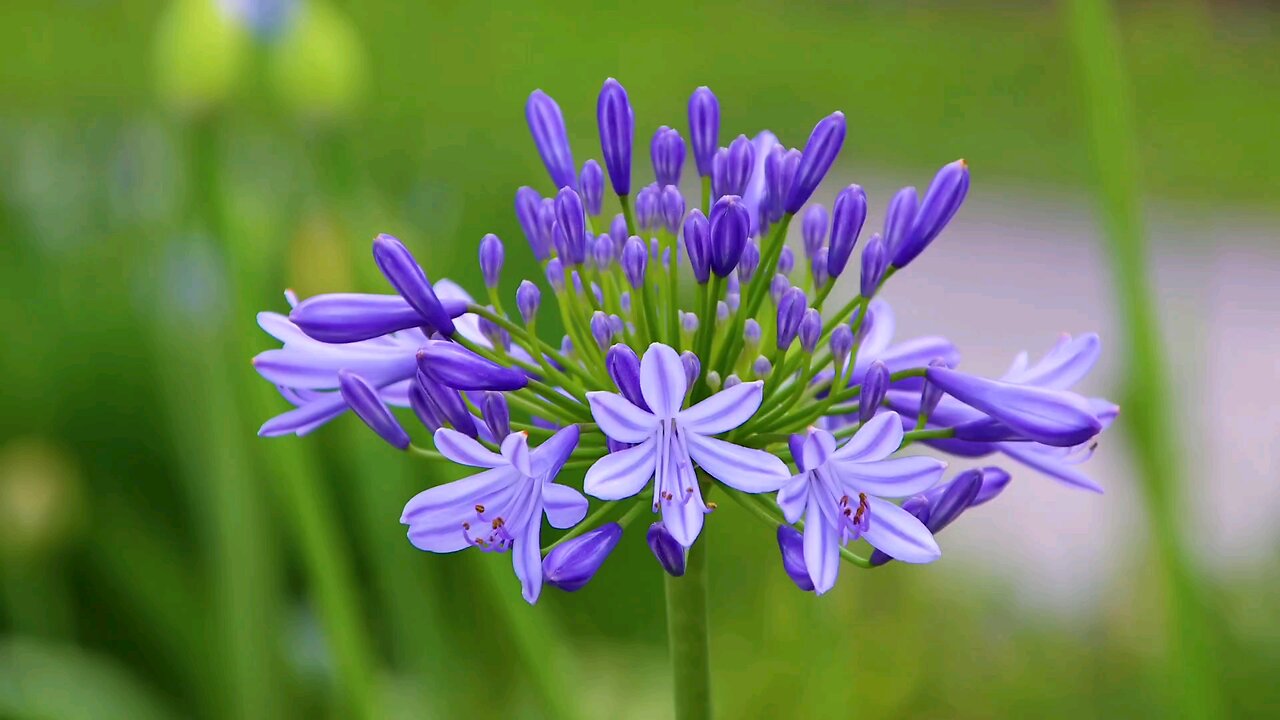Premium Only Content

"African Lily: The Elegant Bloom of Summer The Stunning 'Flower of Love'"
The African lily, also known as Agapanthus, is a striking and popular flowering plant native to South Africa. Its name, Agapanthus, comes from the Greek words "agape" (love) and "anthos" (flower), translating to "flower of love." It belongs to the Amaryllidaceae family and is widely cultivated in gardens and landscapes around the world for its beautiful, showy blooms.
Physical Characteristics
The African lily is known for its striking blue, purple, or white flowers, which appear in large, spherical clusters on tall stems. These flowers bloom from summer to early fall and are especially attractive in borders or as ornamental plants.
1. Leaves: The plant has long, strap-shaped leaves that grow in clumps, creating a lush, fountain-like appearance. The leaves are typically green, but some cultivars may have variegated patterns.
2. Flowers: The blooms are trumpet-shaped and grow in clusters (called umbels) at the top of tall, slender stems that can reach 60–100 cm (24–39 inches) in height. Each cluster can hold dozens of individual flowers, making a striking display.
3. Roots: African lilies have fleshy, tuberous roots that store water, making them fairly drought-resistant. This allows them to thrive in warm climates or areas with occasional dry spells.
Varieties
There are two main types of African lilies:
1. Agapanthus praecox: This species is the most common and is known for its larger flowers and evergreen leaves. It's popular in gardens and landscapes due to its long flowering season.
2. Agapanthus africanus: This variety is a little smaller and typically has a shorter flowering season. It is more suited for cooler climates and tends to be less vigorous than A. praecox.
Growing Conditions
African lilies are relatively easy to grow and care for, making them a favorite for gardeners.
1. Sunlight: They prefer full sun but can tolerate partial shade. In hotter climates, they may need some afternoon shade to avoid scorching.
2. Soil: Well-drained soil is essential for African lilies. While they are not too particular about soil type, they prefer slightly acidic to neutral pH levels.
3. Watering: African lilies are drought-tolerant once established, but they benefit from regular watering during their growing season to promote more abundant blooms. Overwatering can lead to root rot, so it’s essential to let the soil dry out between waterings.
4. Climate: These plants are best suited for warm, temperate regions. They can survive mild winters, but in colder climates, they should be grown in containers and brought indoors or covered during the winter.
Maintenance and Care
Fertilizing: Feed African lilies with a balanced fertilizer in the spring and early summer to encourage blooming.
Pruning: Deadhead spent flowers to encourage more blooms and to keep the plant looking tidy. In late fall, cut back the stems and leaves if the plant is being prepared for winter dormancy.
Dividing: African lilies can become crowded over time. They can be divided every 3-4 years to rejuvenate the plant and propagate new ones.
Uses in Landscaping
African lilies are often used as:
Border plants: Their tall flower spikes and clumping growth make them ideal for borders in flower beds.
Container plants: They also grow well in pots and containers, making them versatile for patios and terraces.
Mass plantings: They create a stunning visual effect when planted en masse, particularly in large gardens or public spaces.
Cultural and Symbolic Significance
While Agapanthus is primarily admired for its ornamental beauty, it also carries symbolic meanings. It is often associated with love and beauty, likely due to its name, which translates to "love flower." The African lily is sometimes used in wedding bouquets and ceremonies for this reason.
Conservation and Environmental Impact
In their native habitats of South Africa, Agapanthus grow in rocky, mountainous areas or coastal regions. Due to their hardiness and adaptability, they are not considered endangered. However, in some areas outside their native range, they are classified as invasive species due to their vigorous growth. Gardeners should be cautious about where they plant African lilies, as they may spread quickly and compete with native plants.
Pests and Diseases
African lilies are generally hardy, but they can be affected by a few common pests and diseases:
Slugs and snails: These pests can damage the leaves, particularly in wet conditions.
Root rot: Overwatering or poor drainage can lead to root rot, which may kill the plant.
Gray mold: This fungal disease can affect plants in humid, moist environments, particularly if airflow around the plant is poor.
Conclusion
The African lily (Agapanthus) is a beautiful and resilient plant that adds a dramatic splash of color to gardens and landscapes. With its tall stems, lush green foliage, and abundant blooms, it is a favorite for both amateur and professional gardeners. Its ease of care, tolerance to drought, and adaptability to various growing conditions make it an excellent choice for many different climates and settings.
-
 1:30:23
1:30:23
Twins Pod
13 hours agoHe Went From MARCHING With BLM To Shaking Hands With TRUMP! | Twins Pod - Episode 45 - Amir Odom
126K29 -
 1:02:30
1:02:30
Exploring With Nug
15 hours ago $3.38 earned2 Duck Hunters Missing After Kayak Capsizes!
49.5K2 -
 46:48
46:48
Mally_Mouse
8 hours agoLet's Hang!! -- Opening Christmas gifts from YOU!
65.2K1 -
 44:55
44:55
Athlete & Artist Show
20 days ago $2.04 earnedNHL 4 Nations Snubs, Was Hawk Tuah Coin A Scam?
60.6K -
 33:47
33:47
Stephen Gardner
14 hours ago🔥Pentagon Whistleblower UNLEASHES on Biden and Obama!
119K181 -
 2:20:30
2:20:30
The Dilley Show
15 hours ago $27.96 earnedRoger Stone in Studio plus Q&A Friday! w/Author Brenden Dilley 12/27/2024
97.9K21 -
 1:57:02
1:57:02
The Charlie Kirk Show
13 hours agoThe Great H-1B Battle + AMA | Lomez | 12.27.24
184K291 -
 11:39
11:39
Russell Brand
1 day agoWhat You're Not Being Told About The Syrian War
181K284 -
 DVR
DVR
Bannons War Room
1 year agoWarRoom Live
101M -
 1:49:21
1:49:21
Film Threat
16 hours agoBEST AND WORST OF 2024 + SQUID GAME SEASON 2 | Film Threat Livecast
64.6K6